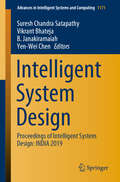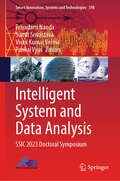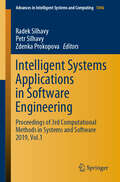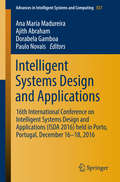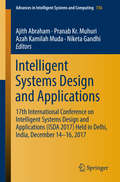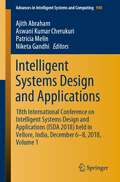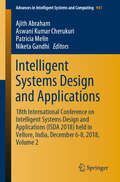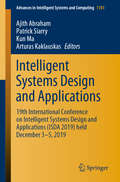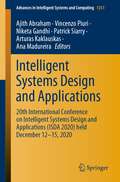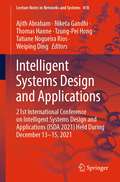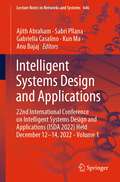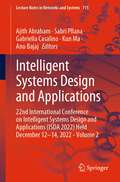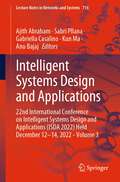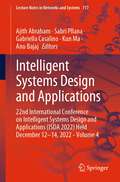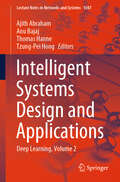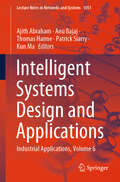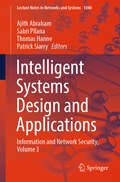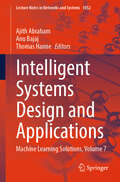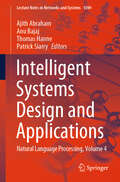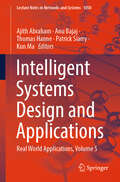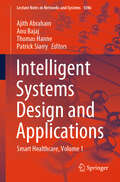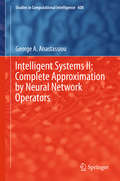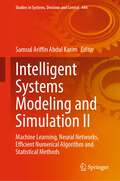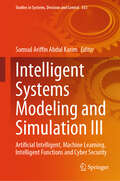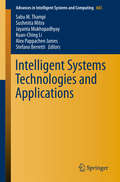- Table View
- List View
Intelligent System Design: Proceedings of Intelligent System Design: INDIA 2019 (Advances in Intelligent Systems and Computing #1171)
by Yen-Wei Chen Suresh Chandra Satapathy Vikrant Bhateja B. JanakiramaiahThis book presents a collection of high-quality, peer-reviewed research papers from the 6th International Conference on Information System Design and Intelligent Applications (INDIA 2019), held at Lendi Institute of Engineering & Technology, India, from 1 to 2 November 2019. It covers a wide range of topics in computer science and information technology, including data mining and data warehousing, high-performance computing, parallel and distributed computing, computational intelligence, soft computing, big data, cloud computing, grid computing and cognitive computing.
Intelligent System and Data Analysis: SSIC 2023 Doctoral Symposium (Smart Innovation, Systems and Technologies #398)
by Sumit Srivastava Vivek Kumar Verma Priyadarsi Nanda Pankaj VyasThis book features original papers from the Doctoral Symposium in 4th International Conference on Smart IoT Systems: Innovations and Computing (SSIC 2023), organized by Manipal University, Jaipur, India, during 26–27 October 2023. It discusses scientific works related to data engineering in the context of computational collective intelligence consisted of interaction between smart devices for smart environments and interactions. The book offers high-quality content and the broad range of topics useful for researchers pursuing advanced studies.
Intelligent Systems Applications in Software Engineering: Proceedings of 3rd Computational Methods in Systems and Software 2019, Vol. 1 (Advances in Intelligent Systems and Computing #1046)
by Radek Silhavy Petr Silhavy Zdenka ProkopovaThis book presents real-world problems and exploratory research that describes novel approaches in software engineering, cybernetics and algorithms in the context of intelligent systems. It constitutes the refereed proceedings of the 3rd Computational Methods in Systems and Software 2019 (CoMeSySo 2019) conference, a groundbreaking online conference that provides an international forum for discussing the latest high-quality research results.
Intelligent Systems Design and Applications
by Ajith Abraham Paulo Novais Ana Maria Madureira Dorabela GamboaThe proceedings of the Third International Conference on Intelligent Systems Design and Applications (ISDA 2003) held in Tulsa, USA, August 10-13. Current research in all areas of computational intelligence is presented including design of artificial neural networks, fuzzy systems, evolutionary algorithms, hybrid computing systems, intelligent agents, and their applications in science, technology, business and commerce. Main themes addressed by the conference are the architectures of intelligent systems, image, speech and signal processing, internet modeling, data mining, business and management applications, control and automation, software agents and knowledge management.
Intelligent Systems Design and Applications: 16th International Conference On Intelligent Systems Design And Applications (isda 2016) Held In Porto, Portugal, December 16-18 2016 (Advances in Intelligent Systems and Computing #23)
by Ajith Abraham Azah Kamilah Muda Niketa Gandhi Pranab Kr. MuhuriThis book highlights recent research on intelligent systems design and applications. It presents 100 selected papers from the 17th International Conference on Intelligent Systems Design and Applications (ISDA 2017), which was held in Delhi, India from December 14 to 16, 2017. The ISDA is a premier conference in the field of Computational Intelligence and brings together researchers, engineers and practitioners whose work involves intelligent systems and their applications in industry and the real world. Including contributions by authors from over 30 countries, the book offers a valuable reference guide for all researchers, students and practitioners in the fields of Computer Science and Engineering.
Intelligent Systems Design and Applications: 18th International Conference on Intelligent Systems Design and Applications (ISDA 2018) held in Vellore, India, December 6-8, 2018, Volume 1 (Advances in Intelligent Systems and Computing #940)
by Ajith Abraham Patricia Melin Aswani Kumar Cherukuri Niketa GandhiThis book highlights recent research on Intelligent Systems and Nature Inspired Computing. It presents 212 selected papers from the 18th International Conference on Intelligent Systems Design and Applications (ISDA 2018) and the 10th World Congress on Nature and Biologically Inspired Computing (NaBIC), which was held at VIT University, India. ISDA-NaBIC 2018 was a premier conference in the field of Computational Intelligence and brought together researchers, engineers and practitioners whose work involved intelligent systems and their applications in industry and the “real world.” Including contributions by authors from over 40 countries, the book offers a valuable reference guide for all researchers, students and practitioners in the fields of Computer Science and Engineering.
Intelligent Systems Design and Applications: 18th International Conference on Intelligent Systems Design and Applications (ISDA 2018) held in Vellore, India, December 6-8, 2018, Volume 2 (Advances in Intelligent Systems and Computing #941)
by Ajith Abraham Patricia Melin Aswani Kumar Cherukuri Niketa GandhiThis book highlights recent research on Intelligent Systems and Nature Inspired Computing. It presents 212 selected papers from the 18th International Conference on Intelligent Systems Design and Applications (ISDA 2018) and the 10th World Congress on Nature and Biologically Inspired Computing (NaBIC), which was held at VIT University, India. ISDA-NaBIC 2018 was a premier conference in the field of Computational Intelligence and brought together researchers, engineers and practitioners whose work involved intelligent systems and their applications in industry and the “real world.” Including contributions by authors from over 40 countries, the book offers a valuable reference guide for all researchers, students and practitioners in the fields of Computer Science and Engineering.
Intelligent Systems Design and Applications: 19th International Conference on Intelligent Systems Design and Applications (ISDA 2019) held December 3-5, 2019 (Advances in Intelligent Systems and Computing #1181)
by Ajith Abraham Patrick Siarry Kun Ma Arturas KaklauskasThis book highlights recent research on intelligent systems and nature-inspired computing. It presents 62 selected papers from the 19th International Conference on Intelligent Systems Design and Applications (ISDA 2019), which was held online. The ISDA is a premier conference in the field of computational intelligence, and the latest installment brought together researchers, engineers and practitioners whose work involves intelligent systems and their applications in industry. Including contributions by authors from 33 countries, the book offers a valuable reference guide for all researchers, students and practitioners in the fields of Computer Science and Engineering.
Intelligent Systems Design and Applications: 20th International Conference on Intelligent Systems Design and Applications (ISDA 2020) held December 12-15, 2020 (Advances in Intelligent Systems and Computing #1351)
by Ajith Abraham Vincenzo Piuri Patrick Siarry Arturas Kaklauskas Ana Madureira Niketa GandhiThis book highlights recent research on intelligent systems and nature-inspired computing. It presents 130 selected papers from the 19th International Conference on Intelligent Systems Design and Applications (ISDA 2020), which was held online. The ISDA is a premier conference in the field of computational intelligence, and the latest installment brought together researchers, engineers and practitioners whose work involves intelligent systems and their applications in industry. Including contributions by authors from 40 countries, the book offers a valuable reference guide for all researchers, students and practitioners in the fields of Computer Science and Engineering.
Intelligent Systems Design and Applications: 21st International Conference on Intelligent Systems Design and Applications (ISDA 2021) Held During December 13–15, 2021 (Lecture Notes in Networks and Systems #418)
by Ajith Abraham Thomas Hanne Tzung-Pei Hong Niketa Gandhi Tatiane Nogueira Rios Weiping DingThis book highlights recent research on intelligent systems and nature-inspired computing. It presents 132 selected papers from the 21st International Conference on Intelligent Systems Design and Applications (ISDA 2021), which was held online. The ISDA is a premier conference in the field of computational intelligence, and the latest installment brought together researchers, engineers and practitioners whose work involves intelligent systems and their applications in industry. Including contributions by authors from 34 countries, the book offers a valuable reference guide for all researchers, students and practitioners in the fields of Computer Science and Engineering.
Intelligent Systems Design and Applications: 22nd International Conference on Intelligent Systems Design and Applications (ISDA 2022) Held December 12-14, 2022 - Volume 1 (Lecture Notes in Networks and Systems #646)
by Ajith Abraham Kun Ma Sabri Pllana Anu Bajaj Gabriella CasalinoThis book highlights recent research on intelligent systems and nature-inspired computing. It presents 223 selected papers from the 22nd International Conference on Intelligent Systems Design and Applications (ISDA 2022), which was held online. The ISDA is a premier conference in the field of computational intelligence, and the latest installment brought together researchers, engineers, and practitioners whose work involves intelligent systems and their applications in industry. Including contributions by authors from 65 countries, the book offers a valuable reference guide for all researchers, students, and practitioners in the fields of computer science and engineering.
Intelligent Systems Design and Applications: 22nd International Conference on Intelligent Systems Design and Applications (ISDA 2022) Held December 12-14, 2022 - Volume 2 (Lecture Notes in Networks and Systems #715)
by Ajith Abraham Kun Ma Sabri Pllana Anu Bajaj Gabriella CasalinoThis book highlights recent research on intelligent systems and nature-inspired computing. It presents 223 selected papers from the 22nd International Conference on Intelligent Systems Design and Applications (ISDA 2022), which was held online. The ISDA is a premier conference in the field of computational intelligence, and the latest installment brought together researchers, engineers, and practitioners whose work involves intelligent systems and their applications in industry. Including contributions by authors from 65 countries, the book offers a valuable reference guide for all researchers, students, and practitioners in the fields of computer science and engineering.
Intelligent Systems Design and Applications: 22nd International Conference on Intelligent Systems Design and Applications (ISDA 2022) Held December 12-14, 2022 - Volume 3 (Lecture Notes in Networks and Systems #716)
by Ajith Abraham Kun Ma Sabri Pllana Anu Bajaj Gabriella CasalinoThis book highlights recent research on intelligent systems and nature-inspired computing. It presents 223 selected papers from the 22nd International Conference on Intelligent Systems Design and Applications (ISDA 2022), which was held online. The ISDA is a premier conference in the field of computational intelligence, and the latest installment brought together researchers, engineers, and practitioners whose work involves intelligent systems and their applications in industry. Including contributions by authors from 65 countries, the book offers a valuable reference guide for all researchers, students, and practitioners in the fields of computer science and engineering.
Intelligent Systems Design and Applications: 22nd International Conference on Intelligent Systems Design and Applications (ISDA 2022) Held December 12-14, 2022 - Volume 4 (Lecture Notes in Networks and Systems #717)
by Ajith Abraham Kun Ma Sabri Pllana Anu Bajaj Gabriella CasalinoThis book highlights recent research on intelligent systems and nature-inspired computing. It presents 223 selected papers from the 22nd International Conference on Intelligent Systems Design and Applications (ISDA 2022), which was held online. The ISDA is a premier conference in the field of computational intelligence, and the latest installment brought together researchers, engineers, and practitioners whose work involves intelligent systems and their applications in industry. Including contributions by authors from 65 countries, the book offers a valuable reference guide for all researchers, students, and practitioners in the fields of computer science and engineering.
Intelligent Systems Design and Applications: Deep Learning, Volume 2 (Lecture Notes in Networks and Systems #1047)
by Ajith Abraham Thomas Hanne Tzung-Pei Hong Anu BajajThis book highlights recent research on intelligent systems and nature-inspired computing. It presents 47 selected papers focused on Deep Learning from the 23rd International Conference on Intelligent Systems Design and Applications (ISDA 2023), which was held in 5 different cities namely Olten, Switzerland; Porto, Portugal; Kaunas, Lithuania; Greater Noida, India; Kochi, India, and in online mode. The ISDA is a premier conference in the field of artificial intelligence, and the latest installment brought together researchers, engineers, and practitioners whose work involves intelligent systems and their applications in industry. ISDA 2023 had contributions by authors from 64 countries. This book offers a valuable reference guide for all scientists, academicians, researchers, students, and practitioners in the field of artificial intelligence and deep learning.
Intelligent Systems Design and Applications: Industrial Applications, Volume 6 (Lecture Notes in Networks and Systems #1051)
by Ajith Abraham Patrick Siarry Thomas Hanne Kun Ma Anu BajajThis book highlights recent research on intelligent systems and nature-inspired computing. It presents 47 selected papers focused on Industrial Applications from the 23rd International Conference on Intelligent Systems Design and Applications (ISDA 2023), which was held in 5 different cities namely Olten, Switzerland; Porto, Portugal; Kaunas, Lithuania; Greater Noida, India; Kochi, India, and in online mode. The ISDA is a premier conference in the field of artificial intelligence, and the latest installment brought together researchers, engineers, and practitioners whose work involves intelligent systems and their applications in industry. ISDA 2023 had contributions by authors from 64 countries. This book offers a valuable reference guide for all industrial specialists, scientists, academicians, researchers, students, and practitioners in the field of artificial intelligence and industrial applications.
Intelligent Systems Design and Applications: Information and Network Security, Volume 3 (Lecture Notes in Networks and Systems #1048)
by Ajith Abraham Patrick Siarry Thomas Hanne Sabri PllanaThis book highlights recent research on intelligent systems and nature-inspired computing. It presents 50 selected papers focused on Information and Network Security from the 23rd International Conference on Intelligent Systems Design and Applications (ISDA 2023), which was held in 5 different cities namely Olten, Switzerland; Porto, Portugal; Kaunas, Lithuania; Greater Noida, India; Kochi, India, and in online mode. The ISDA is a premier conference in the field of artificial intelligence, and the latest installment brought together researchers, engineers, and practitioners whose work involves intelligent systems and their applications in industry. ISDA 2023 had contributions by authors from 64 countries. This book offers a valuable reference guide for all network and security specialists, scientists, academicians, researchers, students, and practitioners in the field of artificial intelligence and information/network security.
Intelligent Systems Design and Applications: Machine Learning Solutions, Volume 7 (Lecture Notes in Networks and Systems #1052)
by Ajith Abraham Thomas Hanne Anu BajajThis book highlights recent research on intelligent systems and machine learning based solutions. It presents 46 selected papers focused on Industrial Applications from the 23rd International Conference on Intelligent Systems Design and Applications (ISDA 2023), which was held in 5 different cities namely Olten, Switzerland; Porto, Portugal; Kaunas, Lithuania; Greater Noida, India; Kochi, India, and in online mode. The ISDA is a premier conference in the field of artificial intelligence, and the latest installment brought together researchers, engineers, and practitioners whose work involves intelligent systems and their applications in industry. ISDA 2023 had contributions by authors from 64 countries. This book offers a valuable reference guide for all industrial specialists, scientists, academicians, researchers, students, and practitioners in the field of artificial intelligence and industrial applications.
Intelligent Systems Design and Applications: Natural Language Processing, Volume 4 (Lecture Notes in Networks and Systems #1049)
by Ajith Abraham Patrick Siarry Thomas Hanne Anu BajajThis book highlights recent research on intelligent systems and nature-inspired computing. It presents 45 selected papers focused on Natural Language Processing from the 23rd International Conference on Intelligent Systems Design and Applications (ISDA 2023), which was held in 5 different cities namely Olten, Switzerland; Porto, Portugal; Kaunas, Lithuania; Greater Noida, India; Kochi, India, and in online mode. The ISDA is a premier conference in the field of artificial intelligence, and the latest installment brought together researchers, engineers, and practitioners whose work involves intelligent systems and their applications in industry. ISDA 2023 had contributions by authors from 64 countries. This book offers a valuable reference guide for all specialists, scientists, academicians, researchers, students, and practitioners in the field of artificial intelligence and Natural Language Processing.
Intelligent Systems Design and Applications: Real World Applications, Volume 5 (Lecture Notes in Networks and Systems #1050)
by Ajith Abraham Patrick Siarry Thomas Hanne Kun Ma Anu BajajThis book highlights recent research on intelligent systems and nature-inspired computing. It presents 47 selected papers focused on Real-World Applications from the 23rd International Conference on Intelligent Systems Design and Applications (ISDA 2023), which was held in 5 different cities namely Olten, Switzerland; Porto, Portugal; Kaunas, Lithuania; Greater Noida, India; Kochi, India and in online mode. The ISDA is a premier conference in the field of artificial intelligence, and the latest installment brought together researchers, engineers, and practitioners whose work involves intelligent systems and their applications in industry. ISDA 2023 had contributions by authors from 64 countries. This book offers a valuable reference guide for all specialists, scientists, academicians, researchers, students, and practitioners in the field of artificial intelligence and real-world applications.
Intelligent Systems Design and Applications: Smart Healthcare, Volume 1 (Lecture Notes in Networks and Systems #1046)
by Ajith Abraham Patrick Siarry Thomas Hanne Anu BajajThis book highlights recent research on intelligent systems and nature-inspired computing. It presents 47 selected papers focused on Smart Healthcare from the 23rd International Conference on Intelligent Systems Design and Applications (ISDA 2023), which was held in 5 different cities namely Olten, Switzerland; Porto, Portugal; Kaunas, Lithuania; Greater Noida, India; Kochi, India, and in online mode. The ISDA is a premier conference in the field of artificial intelligence, and the latest installment brought together researchers, engineers, and practitioners whose work involves intelligent systems and their applications in industry. ISDA 2023 had contributions by authors from 64 countries. This book offers a valuable reference guide for all medical doctors, scientists, academicians, researchers, students, and practitioners in the field of artificial intelligence and smart health care.
Intelligent Systems II: Complete Approximation by Neural Network Operators
by George A. AnastassiouThis monograph is the continuation and completion of the monograph, "Intelligent Systems: Approximation by Artificial Neural Networks" written by the same author and published 2011 by Springer. The book you hold in hand presents the complete recent and original work of the author in approximation by neural networks. Chapters are written in a self-contained style and can be read independently. Advanced courses and seminars can be taught out of this brief book. All necessary background and motivations are given per chapter. A related list of references is given also per chapter. The book's results are expected to find applications in many areas of applied mathematics, computer science and engineering. As such this monograph is suitable for researchers, graduate students, and seminars of the above subjects, also for all science and engineering libraries.
Intelligent Systems Modeling and Simulation II: Machine Learning, Neural Networks, Efficient Numerical Algorithm and Statistical Methods (Studies in Systems, Decision and Control #444)
by Samsul Ariffin Abdul KarimThis book develops a new system of modeling and simulations based on intelligence system. As we are directly moving from Third Industrial Revolution (IR3.0) to Fourth Industrial Revolution (IR4.0), there are many emergence techniques and algorithm that appear in many sciences and engineering branches. Nowadays, most industries are using IR4.0 in their product development as well as to refine their products. These include simulation on oil rig drilling, big data analytics on consumer analytics, fastest algorithm for large-scale numerical simulations and many more. These will save millions of dollar in the operating costs. Without any doubt, mathematics, statistics and computing are well blended to form an intelligent system for simulation and modeling. Motivated by this rapid development, in this book, a total of 41 chapters are contributed by the respective experts. The main scope of the book is to develop a new system of modeling and simulations based on machine learning, neural networks, efficient numerical algorithm and statistical methods. This book is highly suitable for postgraduate students, researchers as well as scientists that have interest in intelligent numerical modeling and simulations.
Intelligent Systems Modeling and Simulation III: Artificial Intelligent, Machine Learning, Intelligent Functions and Cyber Security (Studies in Systems, Decision and Control #553)
by Samsul Ariffin Abdul KarimThis book continues the previous edition: Samsul Ariffin Abdul Karim (2022). Intelligent Systems Modeling and Simulation II: Machine Learning, Neural Networks, Efficient Numerical Algorithm and Statistical Methods, Studies in Systems, Decision and Control (SSDC, volume 444, 22k Access). After two years, Intelligent Systems Modeling and Simulation have evolved tremendously through the latest and advanced emergence technologies and many highly sophisticated algorithms have been developed by blending artificial intelligence (AI) and mathematics, statistics, data modelling and other related research areas. These blends offer many opportunities and further investigations into the overlapand equality between these areas. It is a well-known fact that most industries and companies have utilized this IR4.0 architecture in various levels of manufacturing and decision processes. Besides, nowadays IR5.0 or Society5.0 has also been embedded into various systems in industries as well as in Teaching and Learning (TL). The combination of IR4.0 and Society 5.0 may result in more impactful outcomes, especially in automated decision-making and reliable simulations-based modelling. Furthermore, IR4.0 and Society5.0 through Data-Driven have made a significant contribution to the government and companies to analyse big data via predictive analytics. Cyber security firewalls on all systems must be up to date to prevent any malicious attacks by hackers. Otherwise, our citizens might be scammed and according to NBC News, the total loss for 2022 is around USD 8.8 billion. These are very huge amount. Just recently, COVID-19 has been spreading all over the world again. To assist the Ministry of Health (MOH) and other government agencies, it is very crucial to identify, predict, detect and quarantine the COVID-19 on the susceptible persons soonest possible. Intelligent Image Processing techniques are very demanding here. This is to ensure that we can control and minimise the spread. Inspire by these latest developments, in this book, various experts in the areas of Artificial Intelligence, Machine Learning, Deep Learning, Neural Networks, Modeling and Simulation, Cyber Security and Awareness, Intelligent Statistical Methods, Big Data Analytics, Sentiment Analytics, Intelligent Function Approximation, Image Processing in medical imaging especially on COVID-19, AI in Teaching and Learning, and Computational Intelligence will share their latest studies and experiences. Their finding is in line with United Nations Sustainable Development Goals (SDGs) such as No. 9: Industry, Innovation, and Infrastructure, particularly Target 9.4, 9.5, 9.a, 9.b and 9.c, No. 11: Sustainable Cities and Communities particularly Target 11.b and Indicators 11.b.1 and 11.b.2, and SDG No. 4: Quality Education; particularly Target 4.7 and Indicator 4.7.1. This book is highly suitable for postgraduate students and researchers to get the state-of-the-art current research directions as well as for the scientists that have an interest and working in intelligent numerical modelling and simulations through AI, Machine Learning, Neural Networks, and its related counterparts.
Intelligent Systems Technologies and Applications: Volume 2 (Advances In Intelligent Systems And Computing #385)
by Kuan-Ching Li Sushmita Mitra Sabu M. Thampi Jayanta Mukhopadhyay Alex Pappachen James Stefano BerrettiThis book constitutes the thoroughly refereed post-conference proceedings of the third International Symposium on Intelligent Systems Technologies and Applications (ISTA'17), September 13-16, 2017, Manipal, Karnataka, India. All submissions were evaluated on the basis of their significance, novelty, and technical quality. This proceedings contains 34 papers selected for presentation at the Symposium.
